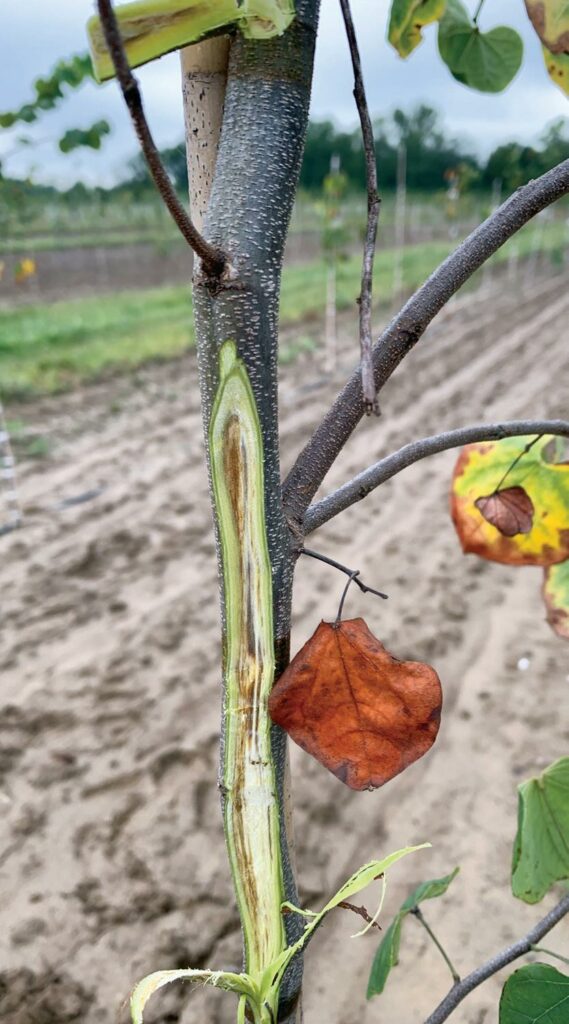New Vascular Streak Dieback Fact Sheet
go.ncsu.edu/readext?939940
en Español / em Português
El inglés es el idioma de control de esta página. En la medida en que haya algún conflicto entre la traducción al inglés y la traducción, el inglés prevalece.
Al hacer clic en el enlace de traducción se activa un servicio de traducción gratuito para convertir la página al español. Al igual que con cualquier traducción por Internet, la conversión no es sensible al contexto y puede que no traduzca el texto en su significado original. NC State Extension no garantiza la exactitud del texto traducido. Por favor, tenga en cuenta que algunas aplicaciones y/o servicios pueden no funcionar como se espera cuando se traducen.
Português
Inglês é o idioma de controle desta página. Na medida que haja algum conflito entre o texto original em Inglês e a tradução, o Inglês prevalece.
Ao clicar no link de tradução, um serviço gratuito de tradução será ativado para converter a página para o Português. Como em qualquer tradução pela internet, a conversão não é sensivel ao contexto e pode não ocorrer a tradução para o significado orginal. O serviço de Extensão da Carolina do Norte (NC State Extension) não garante a exatidão do texto traduzido. Por favor, observe que algumas funções ou serviços podem não funcionar como esperado após a tradução.
English
English is the controlling language of this page. To the extent there is any conflict between the English text and the translation, English controls.
Clicking on the translation link activates a free translation service to convert the page to Spanish. As with any Internet translation, the conversion is not context-sensitive and may not translate the text to its original meaning. NC State Extension does not guarantee the accuracy of the translated text. Please note that some applications and/or services may not function as expected when translated.
Collapse ▲Since vascular streak dieback of some commonly grown nursery ornamentals has become a concern for many growers, it is important to be aware of new releases of information about this issue. Currently several University diagnostic clinics such as those at Purdue University and NC State University have confirmed vascular steak dieback on the following species:
- Eastern Redbud (Cercis canadensis)
- Flowering dogwood (Cornus florida)
- Black gum (Nyssa sylvatica)
- Wax myrtle (Myrica cerifera)
- Southern catalpa (Catalpa bignonioides)
- Northern catalpa (Catalpa speciosa)
- Sweetshrub (Calycanthus floridus)
- Spicebush (Lindera benzoin)
- Umbrella magnolia (Magnolia tripetala)
- Green hawthorn (Crataegus viridis)
- Chinese plum (Prunus salicina)
- Red maple (Acer rubrum)
- Feeman’s maple (Acer x freemanii)
- Witch hazel (Hamamelis virginiana)
- Paperbark maple (Acer griseum)
- Serviceberry (Amelanchier canadensis)
- Kousa dogwood (Cornus kousa)
- Witch-alder (Fothergilla spp.)
- Tulip poplar (Liriodendron tulipifera)
- Fragrant sumac (Rhus aromatica)
- Giant tree lilac (Syringa reticulata)
According to Mike Munster at the NC State University Plant Disease and Insect Clinic, Cercis canadensis is by far the most common species affected, distantly followed by Cornus florida, and maples (Acer spp.) are possibly third most affected.
Recently Virginia Cooperative Extension released a new online fact sheet titled Vascular Streak Dieback: An Emerging Problem on Woody Ornamentals in the U.S. This publication contains information about the current situation, symptoms, what we know and don’t know, avoidance, management, and lab diagnosis. It does list some information about fungicides. However, keep in mind that the potential causal disease species for vascular streak dieback has not been scientifically confirmed and thus no fungicide trials have been conducted, so there are no current official recommendations for management or prevention with fungicides.





